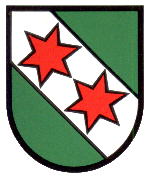Zauggenried: Difference between revisions
Jump to navigation
Jump to search
Knorrepoes (talk | contribs) No edit summary |
Knorrepoes (talk | contribs) m (Text replace - "[[Literature" to "{{media}} [[Literature") |
||
| Line 17: | Line 17: | ||
====Origin/meaning==== | ====Origin/meaning==== | ||
The arms were devised in 1933 and are based on the arms of the Lords of [[Kyburg]], who used two lions and a bend. The family held some possessions in the area in the Middle Ages. The colour of the field was made green, as a canting symbol for Ried (area cleared for agriculture). The two stars represent the villages Zauggenried and Moos. | The arms were devised in 1933 and are based on the arms of the Lords of [[Kyburg]], who used two lions and a bend. The family held some possessions in the area in the Middle Ages. The colour of the field was made green, as a canting symbol for Ried (area cleared for agriculture). The two stars represent the villages Zauggenried and Moos. | ||
{{media}} | |||
[[Literature]] : Wappenbuch des Kantons Bern, 1981. | [[Literature]] : Wappenbuch des Kantons Bern, 1981. | ||
Revision as of 09:26, 9 July 2014
| Heraldry of the World Civic heraldry of Switzerland - Schweizer Wappen / Armorial de Suisse |
ZAUGGENRIED
Canton : Bern
Incorporated into : 2014 Fraubrunnen
Official blazon
Origin/meaning
The arms were devised in 1933 and are based on the arms of the Lords of Kyburg, who used two lions and a bend. The family held some possessions in the area in the Middle Ages. The colour of the field was made green, as a canting symbol for Ried (area cleared for agriculture). The two stars represent the villages Zauggenried and Moos.
Contact and Support
Partners:
Your logo here ?
Contact us
© since 1995, Heraldry of the World, Ralf Hartemink 
Index of the site
Literature : Wappenbuch des Kantons Bern, 1981.











